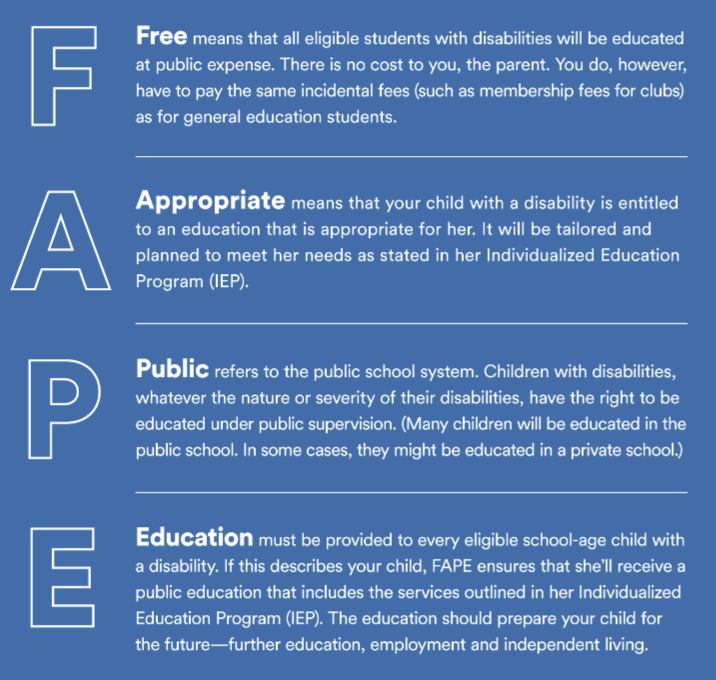Rethinking “Appropriate” in Co-Taught Classrooms
A MiddleWeb Blog
 We have come so far in special education history. We have evolved from a time of complete segregation to find ourselves within a process of a strong, enduring inclusive movement. A movement that is unstoppable!
We have come so far in special education history. We have evolved from a time of complete segregation to find ourselves within a process of a strong, enduring inclusive movement. A movement that is unstoppable!
We can thank civil rights activists and progressive federal laws (IDEA) (and some fair-minded judges too) for today’s commitment to protect every person’s right to access a free and appropriate public education (FAPE).
Yes, we’ve come a long way, and yet, as we continue to celebrate the progress made over the decades, we must act with steady strength to keep our enduring, inclusive movement moving forward. And it is going to take much more than laws to get us to a place we need to be.
Source: Understood. Click to enlarge.
We live in a society and we have to acknowledge that it is people within our society who create the barriers we continue to face. Regardless of laws, people think and act in ways that support or tear down opportunity.
We have the legal and moral high ground as we advocate for the rights of students with disabilities. And now it is (beyond) time to redirect, refocus, and reactivate the appeal to basic human values as we continue our unrelenting commitment to a strong, enduring, inclusive public education system.
Supreme Court decision spotlights ‘appropriate’
Before 1975, the struggle to establish the educational rights of students with disabilities was a slow progression. With the passage of Public Law 94-142 we picked up the pace, making greater and greater strides. And here we are! With laws that protect—and advocates willing to raise their voices—we continue to move in the right direction.
Produced by students at The College of New Jersey (2013)
The recent (March 2017) unanimous Supreme Court ruling in Endrew F. v. Douglas County School District made national headlines with the decision to ensure high expectations and educational opportunities for all students with disabilities. And it stirred up much needed and “about time!” conversations about what kind of educational outcomes should be expected under the Individuals with Disabilities Education Act (IDEA).
Specifically, what exactly does “appropriate” mean? What does it look like? And most important: Are today’s students with disabilities actually receiving the level of “appropriate” education that is the right of every individual student protected by law?
Co-Teacher MUST DOs
So what does all this mean for co-teachers? Every student has a right to a free and appropriate public education. At its core, IDEA is about providing meaningful, accessible, and equitable educational experiences for all students. Yet, when it comes to decisions on meeting the needs of students with disabilities, co-teachers have a lot of communicating and planning to do! Special education teachers and general education teachers must unite.
1. Review the IEP—and Weave IN: Align the specific accommodations or modifications with the natural learning process that is already happening in the room. Weave them in with a focus on supporting high expectations and manageable outcomes—as stated by each student’s personal IEP.
2. Design the Learning: Apply co-teaching models—such as station teaching—to allow each teacher to weave in specialized IEP goals and accommodations. Apply Universal Design for Learning strategies to stay focused on the same learning goals for all students while being flexible and designing a process that meets the needs of each learner in the room.
3. Rotate Teaching Roles: Provide explicit instruction and use scaffolding as you guide learners toward becoming self-regulated learners. Teachers should create a flow where each teacher works with all students. No teacher is stigmatized as the “helper” teacher for “those” students who struggle. That’s not acceptable.
Flexible groupings of students and free flowing teacher movements create a truly inclusive environment where each student receives what he or she needs and both teachers provide their expertise within the learning moments. YES!
4. Equality vs. Equity. There is a difference. Equitable educational experiences are what we are going for in any classroom. Equitable ensures that each learner receives what he or she needs. That’s different than achieving “equality.” Some teachers think being “fair” means doing the same thing for all students. NO.
Fair (in the words of Richard Lavioe) means every students gets what he or she needs, embracing individual strengths and needs. YES! Plan for accessible, equitable learning in your classroom. And realign your vision of what is fair if need be.
5. Parent Communication: Devise a plan where both teachers communicate with all parents. Make it a natural regular occurrence by making sure both teachers are informed, supportive, and ready to communicate. This will go a long way in breaking through any attitudinal barriers (on the part of parents OR teachers) and creating a truly inclusive learning community.
6. Reflect Times TWO! Make time to exchange your thoughts, ideas, and expertise for what is happening in your co-taught classroom. Think about what each students needs…and how you—yes, both of YOU!—can make it happen. Then combine your skills and energy, making every effort to communicate. Then, and only then, will the two teachers in the room truly accentuate the Appropriate in FAPE!
Check in with yourself and your co-teacher:
✻ What are you doing to ensure your instructional decisions are indeed appropriate for each learner in your room?
✻ After reading this post, what could your next step be in raising the bar on advocacy in your classroom?
✻ What is EACH teacher DOING to illuminate the human side of educating all students?
Feature image source.




































